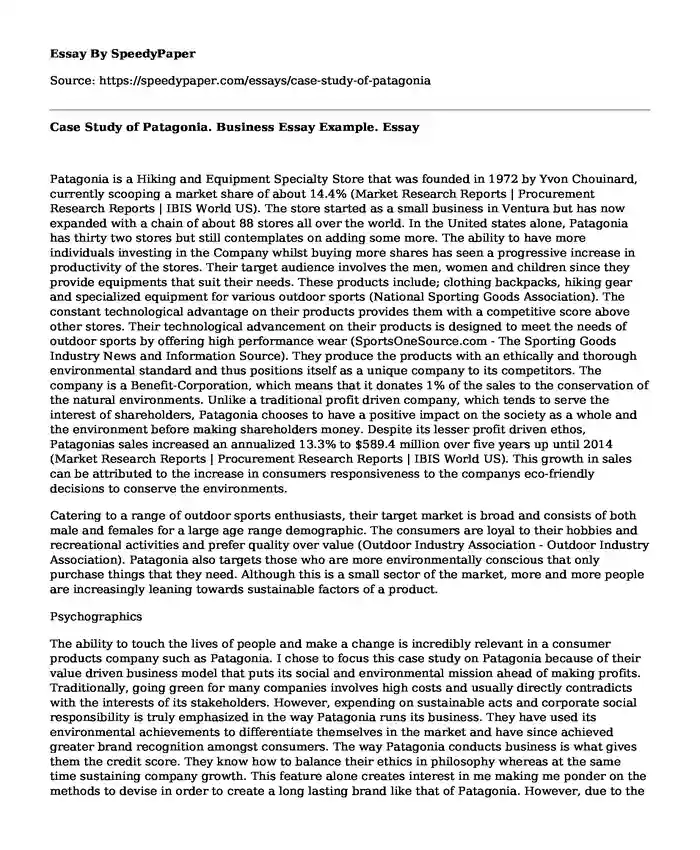
| Type of paper: | Essay |
| Categories: | Management Marketing Case study |
| Pages: | 3 |
| Wordcount: | 767 words |
Patagonia is a Hiking and Equipment Specialty Store that was founded in 1972 by Yvon Chouinard, currently scooping a market share of about 14.4% (Market Research Reports | Procurement Research Reports | IBIS World US). The store started as a small business in Ventura but has now expanded with a chain of about 88 stores all over the world. In the United states alone, Patagonia has thirty two stores but still contemplates on adding some more. The ability to have more individuals investing in the Company whilst buying more shares has seen a progressive increase in productivity of the stores. Their target audience involves the men, women and children since they provide equipments that suit their needs. These products include; clothing backpacks, hiking gear and specialized equipment for various outdoor sports (National Sporting Goods Association). The constant technological advantage on their products provides them with a competitive score above other stores. Their technological advancement on their products is designed to meet the needs of outdoor sports by offering high performance wear (SportsOneSource.com - The Sporting Goods Industry News and Information Source). They produce the products with an ethically and thorough environmental standard and thus positions itself as a unique company to its competitors. The company is a Benefit-Corporation, which means that it donates 1% of the sales to the conservation of the natural environments. Unlike a traditional profit driven company, which tends to serve the interest of shareholders, Patagonia chooses to have a positive impact on the society as a whole and the environment before making shareholders money. Despite its lesser profit driven ethos, Patagonias sales increased an annualized 13.3% to $589.4 million over five years up until 2014 (Market Research Reports | Procurement Research Reports | IBIS World US). This growth in sales can be attributed to the increase in consumers responsiveness to the companys eco-friendly decisions to conserve the environments.
Catering to a range of outdoor sports enthusiasts, their target market is broad and consists of both male and females for a large age range demographic. The consumers are loyal to their hobbies and recreational activities and prefer quality over value (Outdoor Industry Association - Outdoor Industry Association). Patagonia also targets those who are more environmentally conscious that only purchase things that they need. Although this is a small sector of the market, more and more people are increasingly leaning towards sustainable factors of a product.
Psychographics
The ability to touch the lives of people and make a change is incredibly relevant in a consumer products company such as Patagonia. I chose to focus this case study on Patagonia because of their value driven business model that puts its social and environmental mission ahead of making profits. Traditionally, going green for many companies involves high costs and usually directly contradicts with the interests of its stakeholders. However, expending on sustainable acts and corporate social responsibility is truly emphasized in the way Patagonia runs its business. They have used its environmental achievements to differentiate themselves in the market and have since achieved greater brand recognition amongst consumers. The way Patagonia conducts business is what gives them the credit score. They know how to balance their ethics in philosophy whereas at the same time sustaining company growth. This feature alone creates interest in me making me ponder on the methods to devise in order to create a long lasting brand like that of Patagonia. However, due to the competitive nature of retail, Patagonia increasingly faces many sustainable initiatives that are similar from its competitors. Patagonias competitive advantage could slowly be lost if its Omni channel strategies are not fully utilized to effectively look ahead of the market and continue to conduct business it its unique way. With already established competitors like REI taking more than 50% of the market shares (Market Research Reports | Procurement Research Reports | IBIS World US), Patagonias direct to consumer stores will fall behind if it does not continue to innovate in this technologically driven retail environment. In order to continue to compete, Patagonia should stand out by increasing its Omni channel presence further with the following strategies as outlined in this case study.
Work Cited
National Sporting Goods Association. N.p., n.d. Web. 30 Apr. 2015.
Outdoor Industry Association - Outdoor Industry Association. N.p., n.d. Web. 30 Apr. 2015.
SportsOneSource.com - The Sporting Goods Industry News and Information Source. N.p., n.d. Web. 30 Apr. 2015.
Market Research Reports | Procurement Research Reports | IBISWorld US. N.p., n.d. Web. 30 Apr. 2015.
"Patagonia Outdoor Clothing and Technical Apparel-Made of Organic and Recycled Materials for Yoga, Climbing, Hiking, Skiing, Surf, Paddling, Fishing..."Patagonia Outdoor Clothing & Gear | Free Shipping over $75. N.p., n.d. Web. 30 Apr. 2015.
Cite this page
Case Study of Patagonia. Business Essay Example.. (2019, May 14). Retrieved from https://speedypaper.com/essays/case-study-of-patagonia
Request Removal
If you are the original author of this essay and no longer wish to have it published on the SpeedyPaper website, please click below to request its removal:
- Ugly Genes - Free Essay on Natural Selection
- Bernie Sanders Standpoint on Social Security
- Were the Founding Fathers Wrong When They Wrote All Men Are Created Equal? Free Essay
- The Inmate World - Essay Sample about Prisons
- Maegan`s Post
- Essay Sample on Research Methods: Qualitative Research. Design
- Free Essay on the History of Comic Books
Popular categories




